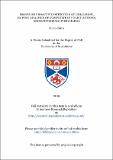Files in this item
Essays on proactive detection of collusion, ex post analysis of competition policy actions, and estimating overcharge
Item metadata
| dc.contributor.advisor | Ulph, David | |
| dc.contributor.author | Corus, Sinan | |
| dc.coverage.spatial | xii, 208 p. | en_US |
| dc.date.accessioned | 2019-10-04T11:18:56Z | |
| dc.date.available | 2019-10-04T11:18:56Z | |
| dc.date.issued | 2018-12-06 | |
| dc.identifier.uri | https://hdl.handle.net/10023/18609 | |
| dc.description.abstract | This work is an empirical analysis of collusion by using a private consumer level data set in a setting where no a priori knowledge of collusion exists. This study benefits from spatial variation in the data. For identification, the relation between price and local market power under different assumptions of conduct is central. Accordingly, first, using a simple theoretical background I provide some theoretical intuition for the measure of local market power used in this work. Second, while controlling for demand and cost shifters and using OLS and GMM, I estimate pricing equations to explore if market patterns are more consistent with collusion or competition. Results suggest that consistent with a regime switch from collusion to competition, stable relations in the market are disrupted after month seven. Third, I estimate the hypothetical overcharge associated with this finding. To this aim, first, I employ the techniques frequently used in collusion retrospectives; second, I propose importing empirical strategies from merger retrospectives. Adopting the techniques that are used widely in merger retrospectives to collusion involves either using i) basic difference-in-difference framework where locations characterised by monopolistic pricing even in competition are set as the control group for the counterfactual of regime switch; or, ii) difference-in-difference framework with treatment intensity, where the regime switch is treated as a treatment, which, at each location, produces heterogeneous effects that is inversely proportional to the level of local market power the provider enjoys at that location. I find that overcharge estimates using alternative methodologies range in 7.48-13.98%. Furthermore, results suggest that if the spatial dynamics are ignored, estimation leads to under-compensation in regions where the market powers of dominant competitor and potential competitor converge; overcompensation in regions where the market powers diverge. Finally, to address the inference problems associated with spatial dependency across observations and difference-in-difference methodology, I apply various remedies proposed in the literature. The findings are robust to alternative methods of inference. | en_US |
| dc.description.sponsorship | "This work is funded by University of St Andrews (School of Economics and Finance). This work is funded by the Economic and Social Research Council (reference number: 1506433)." -- Acknowledgements | en |
| dc.language.iso | en | en_US |
| dc.publisher | University of St Andrews | |
| dc.title | Essays on proactive detection of collusion, ex post analysis of competition policy actions, and estimating overcharge | en_US |
| dc.type | Thesis | en_US |
| dc.contributor.sponsor | University of St Andrews. School of Economics & Finance | en_US |
| dc.contributor.sponsor | Economic and Social Research Council (ESRC) | en_US |
| dc.type.qualificationlevel | Doctoral | en_US |
| dc.type.qualificationname | PhD Doctor of Philosophy | en_US |
| dc.publisher.institution | The University of St Andrews | en_US |
This item appears in the following Collection(s)
Items in the St Andrews Research Repository are protected by copyright, with all rights reserved, unless otherwise indicated.

